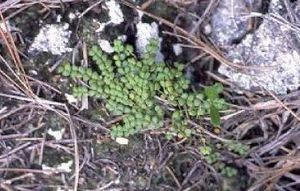Euphorbia deltoidea facts for kids
Quick facts for kids Euphorbia deltoidea |
|
|---|---|
 |
|
| subsp. deltoidea | |
| Scientific classification | |
| Genus: |
Euphorbia
|
| Species: |
deltoidea
|
| Synonyms | |
|
List
Chamaesyce deltoidea (Engelm. ex Chapm.) Small
Chamaesyce deltoidea subsp. serpyllum (Small) D.G.Burch Chamaesyce serpyllum Small Euphorbia deltoidea var. serpyllum (Small) Oudejans Chamaesyce adhaerens Small Chamaesyce deltoidea var. adhaerens (Small) D.G.Burch Chamaesyce deltoidea subsp. adhaerens (Small) A.Herndon Euphorbia deltoidea var. adhaerens (Small) Oudejans Chamaesyce deltoidea subsp. pinetorum (Small) A.Herndon Chamaesyce pinetorum Small Euphorbia pinetorum G.L.Webster Euphorbia smallii Oudejans |
|
The Deltoid Spurge (Euphorbia deltoidea) is a special flowering plant. It is found only in Florida in the United States. Scientists sometimes group different types of this plant in slightly different ways. One type, called ssp. deltoidea, is a federally endangered species. This means it is at risk of disappearing forever.
This specific type of Deltoid Spurge is found only in Miami-Dade County. Another type, ssp. adhaerens, is often counted with it. This makes it tricky to know the exact number of endangered plants. To make it simpler, any Deltoid Spurge found in Miami-Dade County is considered endangered.
Contents
What is the Deltoid Spurge?
The Deltoid Spurge is a small plant. It is part of the Euphorbia plant family. This plant is unique because it only grows in Florida. It is a very rare plant.
Where Does it Live?
The Deltoid Spurge grows in South Florida. Its home is a special type of forest called pine rocklands. These forests are also becoming very rare. The plant likes open, sunny spots within these forests.
Why is it Special?
The Deltoid Spurge is special because it is an endangered species. This means there are very few of these plants left. It is important to protect them so they do not vanish. Most of these endangered plants live in Miami-Dade County.
Why is the Deltoid Spurge in Danger?
The Deltoid Spurge faces many threats. Its home is shrinking fast. Other plants are also causing problems for it.
Losing Its Home
Miami-Dade County is a very busy place. Many buildings and roads have been built there. About 98% of the Deltoid Spurge's natural home has been changed or destroyed. This is the main reason why the plant is so rare now.
The Role of Fire
The pine rocklands where the plant lives need fires. These fires happen naturally from time to time. They help clear away dead leaves and other plants. This lets the Deltoid Spurge get enough sunlight. Without fires, other plants grow too tall and block the sun. People in Miami-Dade County often stop these natural fires. This makes it harder for the Deltoid Spurge to grow.
Unwanted Guests
Invasive plants are also a big problem. These are plants that are not native to Florida. They grow very fast and take over the space. One example is Burma reed (Neyraudia reynaudiana). It can crowd out the Deltoid Spurge.

